Parque Santokki (산토끼 노래동산)
.0M 2023-06-28
Ibang-ro 623, Ibang-myeon, Changnyeong-gun, Gyeongsangnam-do
Pantano Upo de Changnyeong (창녕 우포늪)
3.9Km 2023-02-17
Uponeup-gil 220, Yueo-myeon, Changnyeong-gun, Gyeongsangnam-do.
Siendo el pantano natural más grande de la península coreana, se encuentra en los alrededores de los distritos de Yueo-myeon, Ibang-myeon, y Daehap-myeon del distrito Changnyeong-gun, de la provincia de Gyeongsangnam-do. Tiene un contorno de 7,5 km, con una superficie total de 2.314.060 m².
Según los registros, hace más de 140 millones de años que el pantano comenzó a formarse. Durante la Era de los dinosaurios, comenzó a subir el nivel del mar en la región del río Nakdonggang, y esto provocó que las tierras circundantes se sumergieran. Así fue que las aguas que fluían por el río Nakdonggang se hayan quedado estancadas, permitiendo la creación del pantano y del lago natural y convirtiéndose en un espacio recreativo de los dueños de la tierra de aquella época, los dinosaurios.
Hoy en día, en esta región se pueden observar huellas fosilizadas de los dinosaurios, que se deducen que fueron de aquellos tiempos. En particular, en el año 1997 fue designado “Zona de Protección Ecológica”, y según el Convenio de Ramsar, fue declarada “Humedales de Importancia Internacional” (1998), lo cual ha ayudado a que el pantano pueda conservarse y mantenerse.
Actualmente, en el pantano Upo habitan más de 430 especies de plantas del país, lo que corresponde al 10% de la flora total. En particular, con respecto a las plantas acuáticas, residen el 50-60% de todas las especies del país. Esto demuestra la alta calidad ecológica que tiene este medio ambiente acuático. Entre los organismos más comunes de este pantano hay plantas acuáticas como las salvinias, las trapa japónica, mordiscos de rana, flores de loto, etc. Estas plantas son importantes por su sola presencia, ya que ayudan a purificar el agua del pantano, y también a mantenerlas limpias y claras.
Como el pantano es protegida por ser declarada una Zona de Protección Ecológica, se prohíbe pescar o cazar animales.
Centro Ecológico del Pantano Upo (우포늪생태관)
4.8Km 2022-09-21
Uponeup-gil 220, Yueo-myeon, Changnyeong-gun, Gyeongsangnam-do.
Es un lugar que se dedica a investigar y conservar los registros relacionados con la flora y fauna silvestres del pantano (aves, peces, mamíferos, anfibios, reptiles, etc.), también se dedica a exhibirlos al público. Además, trata de dar a conocer que el ser humano también forma parte de la aturaleza y cómo debe convivir conjuntamente con ella. Para que los visitantes puedan percibir la información sobre el entorno ecológico de forma detallada y clara, el centro está compuesto por las siguientes salas temáticas: Introducción al Pantano Upo, Las Estaciones en el Pantano, El Pantano Viviente, Los Familiares del Pantano, Introducción sobre el Entorno Ecológico, etc., cada sala dispone de material tridimensional, vídeos, etc., y también cuenta con programas participativos. El centro es un espacio educativo para los adolescentes, un espacio cultural para todas las personas y un sitio de descanso para las familias. Experimente el pantano viviente y perciba los conocimientos de la naturaleza ecológica del pantano.
Tumbas Antiguas de Gyo-dong y Songhyeon-dong en Changnyeong (창녕 교동과 송현동 고분군)
11.2Km 2023-06-28
Changmil-ro 34, Changnyeong-eup, Changnyeong-gun, Gyeongsangnam-do
Las tumbas antiguas de Songhyeon-dong en Changnyeong, ubicadas debajo de la fortaleza Mokmasanseong, en el pie oeste del monte Hwawangsan, son grandes sepulturas que están junto a la carretera que conduce a Hyeonpung. Las tumbas antiguas de Gyo-dong, por su parte, son docenas de sepulturas que alguna vez estuvieron reunidas alrededor de una gran tumba real y que ahora quedan entre las ocho tumbas con montículos dañados. Algunas de estas tumbas fueron excavadas por los japoneses entre 1918 y 1919, y la mayoría de las reliquias fueron llevadas a Japón. Solo algunas de ellas permanecen en Corea. De acuerdo con los resultados de la investigación hecha en ese momento, las tumbas grandes se construyeron en forma de pasadizo o en forma de puerta de entrada.
Se dice que se excavaron una gran cantidad de reliquias, como joyas hechas de varios metales preciosos, incluidas coronas de oro, trasplantes de oro puro y cobre, armaduras de hierro y loza. El informe de excavación dejado por los japoneses es simple, por lo que no es posible captar con precision la estructura de las tumbas de Gyo-dong y las reliquias excavadas. Veintiuna de las tumbas existentes han sido restauradas hasta el momento, y solo una de ellas tiene una entrada accesible.
Las tumbas en Songhyeon-dong se dividen en gran parte en dos áreas. El Área 1 solía ser de tumbas grandes, con 80 de ellas al oeste del pie del monte Mokmasan, pero ahora solo quedan unas 16 sepulturas. Se dice que había alrededor de 20 en el Área 2, cerca del Buda de piedra en Songhyeon-dong, pero ahora la mayoría de ellas se han convertido en arrozales y solo unas pocas tumbas revelan su apariencia original. Dado que estas tumbas están cerca de las de Gyo-dong, se cree que la estructura de las mismas y la naturaleza de las reliquias son casi las mismas. Junto con las tumbas de Gyo-dong, se excavó una gran cantidad de reliquias en 1918, pero se desconoce el paradero de algunas de ellas.
Academia Neoconfuciana Dodong Seowon (도동서원) [Patrimonio Cultural de la Humanidad de la Unesco]
13.7Km 2023-01-05
Gujiseo-ro 726, Guji-myeon, Dalseong-gun, Daegu
+82-53-688-3162
La Academia Neoconfuciana Dodong Seowon está situada en Daegu y es una de las cinco escuelas confucianas más grandes de Corea, junto con Byeongsan Seowon, Oksan Seowon, Sosu Seowon y Dosan Seowon. El instituto fue creado por estudiosos confucianos en 1568, al este del monte Biseulsan, fue destruido durante la invasión japonesa en 1592, y reconstruido en 1605, bajo el nombre de Borodong. Años después se le llamaría Dodong, que significa las enseñanzas (do) del confucianismo que viene del este (dong). Algunas partes que merece la pena visitar del instituto son la puerta de la tierra, una sala llamada Jungjeongdang, el pabellón Suwollu, y los árboles ginkgo de más de 400 años. Dentro de la sala Jungjeongdang hay una escultura con 4 cabezas de dragón, llamada Samuljan, que simboliza las enseñanzas de Confucio.
Ungidaek House / 개실마을영농조합법인(웅기댁)
17.0Km 2025-08-13
32, Gaesil 1-gil, Ssangnim-myeon, Goryeong-gun, Gyeongsangbuk-do
+82-54-956-4022 / +82-10-3207-4022
Ungidaek House of the Gaesil Village Farming Association Corporation is distinctive for its red clay exterior. This cozy hanok comprises two rooms: Juksil, which accommodates 6 people, and Maesil, which is suitable for 4 people. Each room is decorated with white wallpaper and a red clay floor sheet, and is equipped with TV, air-conditioner, toiletries, hairdryer, table, and other amenities. Each room has an ensuite bathroom and cooking equipment.
Known as the village of the Seonsan Kim clan, Gaesil Village was founded by the descendants of Kim Jong-jik (pen-name: Jeompiljae, 1431-1492), a leading Korean Neo-Confucian scholar of the early Joseon period who died during the Literati Purge of 1498. The head house of Kim Jong-jik (Provincial Folk Material No. 62) and Doyeonjae (Provincial Cultural Heritage Material No. 111), the old village school, are also situated in the village. In addition, the nearby Daegaya Museum displays the writing accessories of Kim Jong-jik (Provincial Tangible Cultural Heritage No. 209).
The village is also known as Gaehwasil, meaning “a beautiful valley with blooming flowers” as it is surrounded by a flower-covered mountain called Mt. Hwagaesan, a 350-year-old bamboo forest, and Jeopmubong Peak, which is said to resemble a fluttering butterfly. Over 80% of the village houses are traditional hanok buildings nestled amid a cozy environment.
During the Campaign to Create Beautiful Communities conducted in 2001 and the Farm Experience Village Development Project in 2005, the village’s hanok were renovated or entirely rebuilt, earthen-stone walls were built, walking paths created, and refined landscaping works carried out, establishing the village in its current form. Furthermore, a village shelter, experience center, Internet café, and other facilities were built for the convenience of residents and visitors alike. In recognition of the villager’ efforts to revitalize their community, Gaesil was awarded the presidential citation at the Korea Rural Village Awards in 2011.
Designated as a NongHyup’s Farm Stay Village in 2003, Gaesil operates a wide variety of hands-on experience programs relating to nature, agriculture, and local traditions, such as collecting sweet potatoes and rice planting; Korean traditional etiquette and tea ceremony; kite making and straw handicrafts; traditional food experiences such as yeot (Korean hard taffy) and yugwa (deep-fried sweet rice cakes); traditional games such as riding on a swing and neolttwigi (Korean see-saw); as well as loach fishing, ice sledding and so on. Gaesil Village, a representative farm stay village that “blooms” in every season, attracts around 50-60,000 visitors every year.
Yeonpung Gotaek (the Old House of Munchung) / 연풍고택/문충고가
17.0Km 2025-08-12
44, Gaesil 1-gil, Ssangnim-myeon, Goryeong-gun, Gyeongsangbuk-do
+82-54-956-4022 / +82-10-3207-4022
Located in the village of Gaesil in Hapga-ri, Ssangnim-myeon, Goryeong-gun, Gyeongsangbuk-do, the Old House of Yeonpung is an historic 150-year-old house, and was formerly the anchae (the inner house) among the four structures built by the current owners’ ancestor, who served as the governor of Yeonpung-hyeon, Goesan-gun, Chungcheongbuk-do. The house was restored after being bombed during the Korean War, and is currently is used to accommodate visitors or for village events.
The Old House of Yeonpung is situated behind Hwasanjae Pass, which is the traditional wedding experience site of Gaesil village. It is considered a propitious site according to geomantic theory as there is a bamboo forest to its rear. During restoration work in 2010, the large anchae, which covered about 2,644m2, was renovated into a modern structure with four rooms.
In particular, the Juksil and Maesil rooms are very large, making them ideal for families and groups. A separate building with a large courtyard and a BBQ facility is available for guests who want to cook or have a barbecue. The charming courtyard comprises a well, a bench, and various flower trees.
Known as the village of the Seonsan Kim clan, Gaesil Village was founded by the descendants of Kim Jong-jik (pen-name: Jeompiljae, 1431-1492), a leading Korean Neo-Confucian scholar of the early Joseon period who died during the Literati Purge of 1498. The head house of Kim Jong-jik (Provincial Folk Material No. 62) and Doyeonjae (Provincial Cultural Heritage Material No. 111), the old village school, are also situated in the village. In addition, the nearby Daegaya Museum displays the writing accessories of Kim Jong-jik (Provincial Tangible Cultural Heritage No. 209).
The village is also known as Gaehwasil, meaning “a beautiful valley with blooming flowers” as it is surrounded by a flower-covered mountain called Mt. Hwagaesan, a 350-year-old bamboo forest, and Jeopmubong Peak, which is said to resemble a fluttering butterfly. Over 80% of the village houses are traditional hanok buildings nestled amid a cozy environment.
During the Campaign to Create Beautiful Communities conducted in 2001 and the Farm Experience Village Development Project in 2005, the village’s hanok were renovated or entirely rebuilt, earthen-stone walls were built, walking paths created, and refined landscaping works carried out, establishing the village in its current form. Furthermore, a village shelter, experience center, Internet café, and other facilities were built for the convenience of residents and visitors alike. In recognition of the villager’ efforts to revitalize their community, Gaesil was awarded the presidential citation at the Korea Rural Village Awards in 2011.
Designated as a NongHyup’s Farm Stay Village in 2003, Gaesil operates a wide variety of hands-on experience programs relating to nature, agriculture, and local traditions, such as collecting sweet potatoes and rice planting; Korean traditional etiquette and tea ceremony; kite making and straw handicrafts; traditional food experiences such as yeot (Korean hard taffy) and yugwa (deep-fried sweet rice cakes); traditional games such as riding on a swing and neolttwigi (Korean see-saw); as well as loach fishing, ice sledding and so on. Gaesil Village, a representative farm stay village that “blooms” in every season, attracts around 50-60,000 visitors every year.
The House of Soccer kkumnamu (Future Soccer Player) / 축구꿈나무집
17.0Km 2025-08-13
32, Gaesil 1-gil, Ssangnim-myeon, Goryeong-gun, Gyeongsangbuk-do
+82-54-956-4022 / +82-10-3207-4022
The House of Soccer kkumnamu (The House of Future Soccer Player) of the Gaesil Village Farming Association Corporation is a hanok-style accommodation complete with a grassy field and a courtyard filled with well-kept flowerpots, creating a serene atmosphere around the hanok. The house has two Korean-style rooms with a capacity of two to four people. The Nansil room also has a kitchen. This cozy hanok is equipped with modern facilities for guests’ comfort and convenience, as well as the full range of amenities including TV, fridge, air-conditioner, toiletries, and table. Guests are permitted to hold a BBQ outside provided that they supply the charcoal themselves.
Known as the village of the Seonsan Kim clan, Gaesil Village was founded by the descendants of Kim Jong-jik (pen-name: Jeompiljae, 1431-1492), a leading Korean Neo-Confucian scholar of the early Joseon period who died during the Literati Purge of 1498. The head house of Kim Jong-jik (Provincial Folk Material No. 62) and Doyeonjae (Provincial Cultural Heritage Material No. 111), the old village school, are also situated in the village. In addition, the nearby Daegaya Museum displays the writing accessories of Kim Jong-jik (Provincial Tangible Cultural Heritage No. 209).
The village is also known as Gaehwasil, meaning “a beautiful valley with blooming flowers” as it is surrounded by a flower-covered mountain called Mt. Hwagaesan, a 350-year-old bamboo forest, and Jeopmubong Peak, which is said to resemble a fluttering butterfly. Over 80% of the village houses are traditional hanok buildings nestled amid a cozy environment.
During the Campaign to Create Beautiful Communities conducted in 2001 and the Farm Experience Village Development Project in 2005, the village’s hanok were renovated or entirely rebuilt, earthen-stone walls were built, walking paths created, and refined landscaping works carried out, establishing the village in its current form. Furthermore, a village shelter, experience center, Internet café, and other facilities were built for the convenience of residents and visitors alike. In recognition of the villager’ efforts to revitalize their community, Gaesil was awarded the presidential citation at the Korea Rural Village Awards in 2011.
Designated as a NongHyup’s Farm Stay Village in 2003, Gaesil operates a wide variety of hands-on experience programs relating to nature, agriculture, and local traditions, such as collecting sweet potatoes and rice planting; Korean traditional etiquette and tea ceremony; kite making and straw handicrafts; traditional food experiences such as yeot (Korean hard taffy) and yugwa (deep-fried sweet rice cakes); traditional games such as riding on a swing and neolttwigi (Korean see-saw); as well as loach fishing, ice sledding and so on. Gaesil Village, a representative farm stay village that “blooms” in every season, attracts around 50-60,000 visitors every year.
Lang Studio (랑 스튜디오)
17.0Km 2025-06-04
37, Gaesil 1-gil, Goryeong-gun, Gyeongsangbuk-do
Rang Studio is a white-painted hanok guesthouse in Gaesil Village, Goryeong, Gyeongsangbuk-do - hometown of the descendants of Joseon scholar Kim Jong-jik. The guestroom is equipped with a bathroom plus a kitchen with cooking utensils provided. Therfe is an outdoor barbecue, but visitors should bring their own charcoal. In the village, visitors can experience the atmosphere of the old countryside, sampling traditional farming and craft skills plus traditional pastimes and food.
Hadongdaek House / 하동댁
17.0Km 2025-08-13
45, Gaesil 2-gil, Ssangnim-myeon, Goryeong-gun, Gyeongsangbuk-do
+82-54-956-4022, +82-10-3207-4022
The village of Gaesil is known as the village of the Seonsan Kim clan. It was established by the descendants of Kim Jong-jik (pen-name: Jeompiljae, 1431-1492), a leading Korean Neo-Confucian scholar and the founder of the Yeongnam Sarim faction during the mid-Joseon period. Boasting over 300 years of tradition, the village is home to sixty households as well as a number of cultural heritages including the head house of Kim Jong-jik (Provincial Folk Material No. 62), Doyeonjae (Provincial Cultural Heritage material No. 111), which is the old village school, and the printing woodblocks for a collection of literary works including Yijonrok (a book about the life and achievements of Kim’s father Kim Suk-ja) written by Kim Jong-jik (Provincial Tangible Cultural Heritage No. 175).
The residents have renovated the village’s earthen walls and hanok houses into a current hanok village, and also run various hands-on experience programs including a hanok stay, a farm product cultivation program, and traditional etiquette and games, thereby offering urban travelers an opportunity to experience a truly rural lifestyle. The Hadongdaek House has two traditional Korean-style guestrooms. The Maesil room is equipped with a kitchen and a bathroom, while guests who stay in the Juksil should use the communal bathroom and kitchen outside the room. The well-kept garden harmonizes perfectly with the cozy hanok.
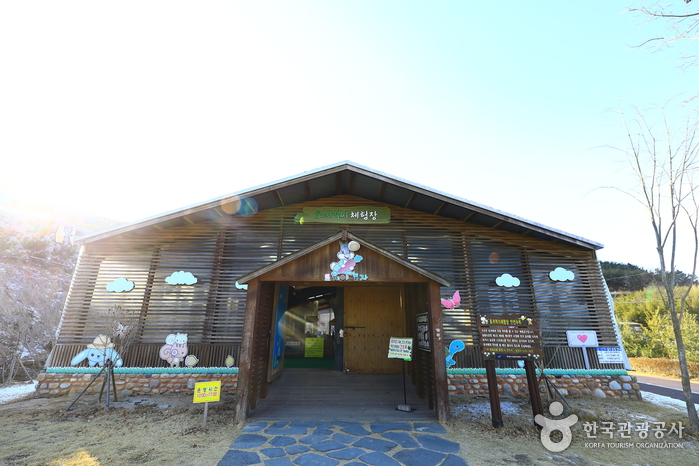
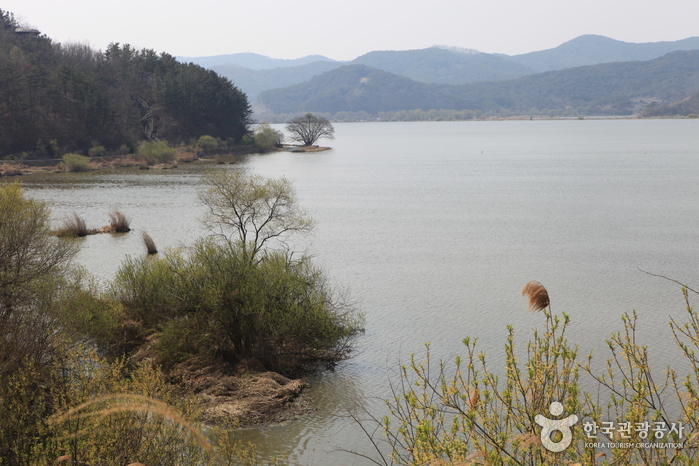
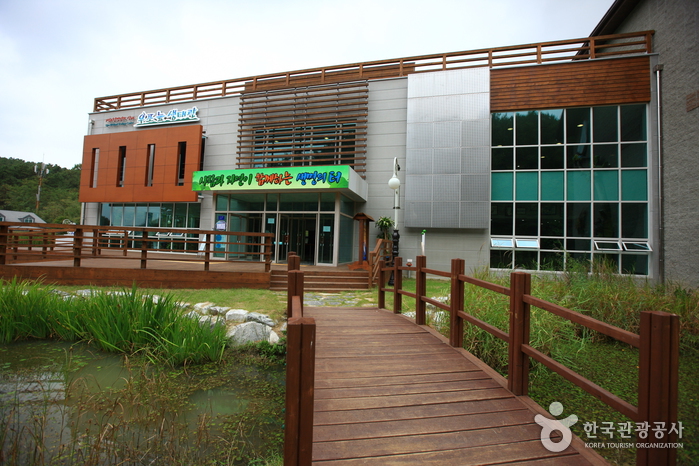
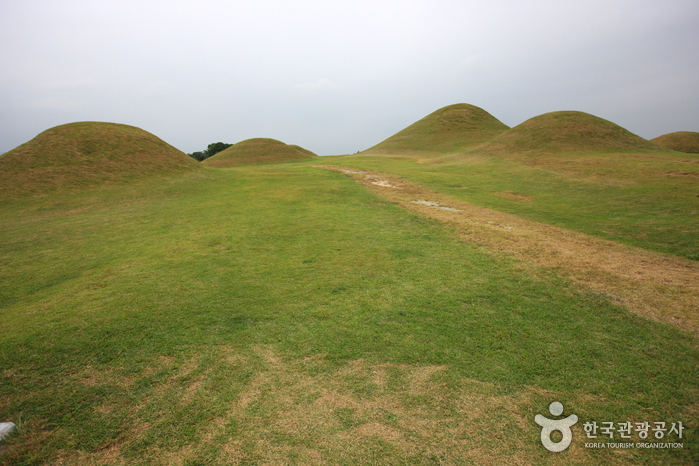

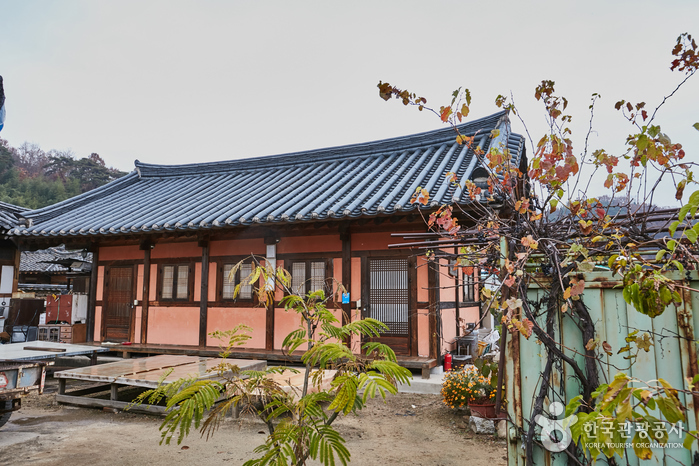
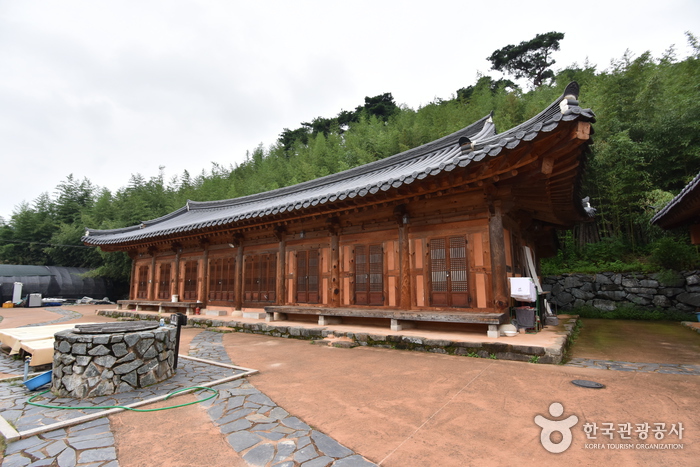
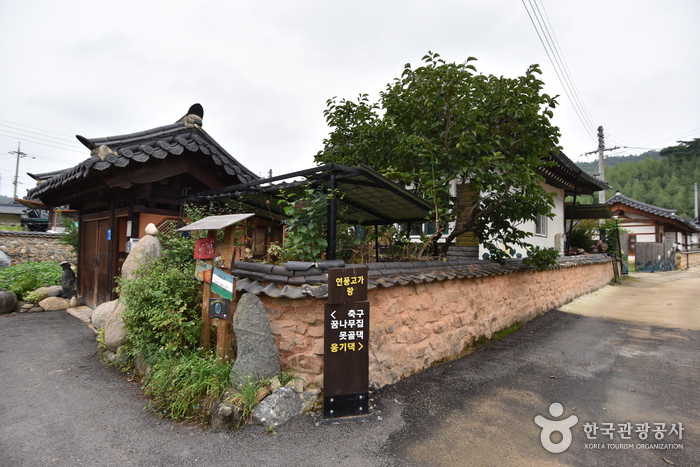
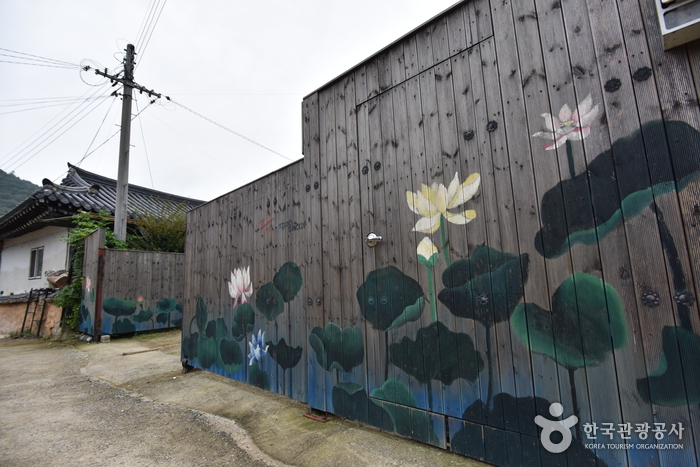
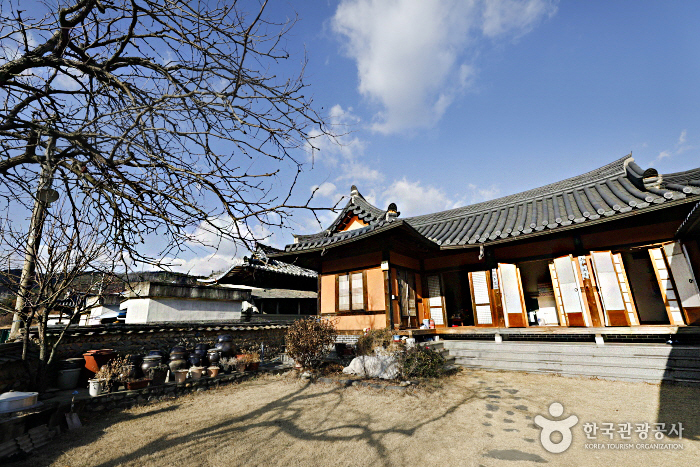
 Español
Español
 한국어
한국어 English
English 日本語
日本語 中文(简体)
中文(简体) Deutsch
Deutsch Français
Français Русский
Русский